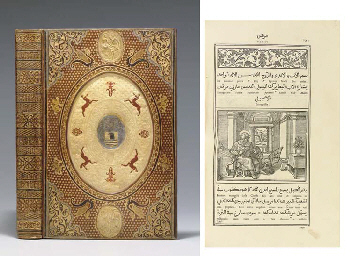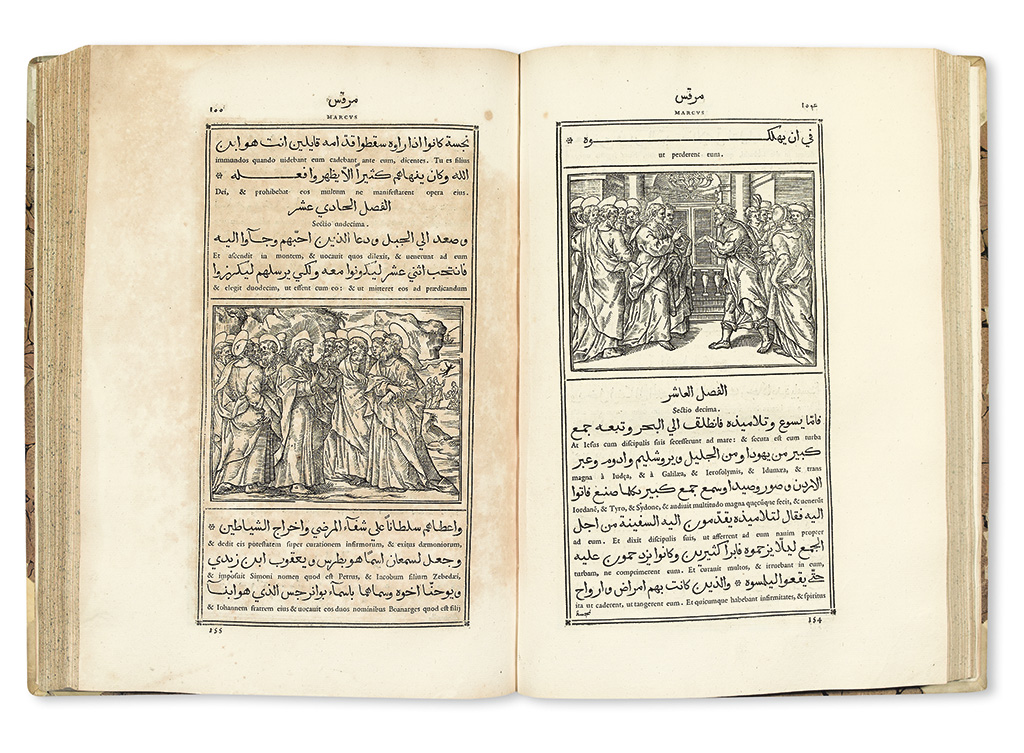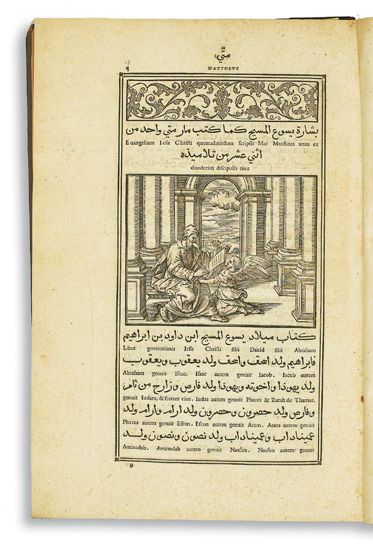BIBLE, GOSPELS, in Arabic and Latin -- Evangelium sanctum . Rome: Typographia Medicea Orientale, 1591.
BIBLE, GOSPELS, in Arabic and Latin -- Evangelium sanctum . Rome: Typographia Medicea Orientale, 1591. A near-complete set of 64 of the 68 woodcut blocks for the illustrations, 11 signed with the monogram of Antonio Tempesta as designer [cf. Nagler I, 506 and 508] and 12 signed with Leonardo Parasole's monogram as cutter [cf. Nagler IV, 1256], with one variant [?possibly later] block for the illustration on p.261 signed with monogram 'CG' [?Giulio Candiotti, cf. Nagler II, 59] and 3 additional woodcut blocks for illustrations not used in the 1591 Arabic and Latin edition, and the woodcut block for the arabesque tailpiece (illustration blocks c. 102 x 125mm, tailpiece block 68 x 67mm), all but 3 of the illustration blocks wrapped in sheets of paper bearing impressions of the woodcuts [possibly taken in the 18th century]. (Occasional slight chipping or splitting, some wormed on back occasionally affecting image, some backs partially or fully detached.) BIBLE, GOSPELS, in Arabic and Latin--[ Evangelium sanctum , Arabic text edited by Giovanni Battista Raimondi, ?Latin translation by Antonius Sionita.] Rome: Typographia Medicea Orientale, 1591. 2° (327 x 224mm). Without title and preliminaries as issued, pp. 9-462 and colophon. Text in Arabic with an interlinear Latin translation within woodcut borders of double rules. 149 woodcut illustrations from 68 blocks, some by Leonardo Parasole after Antonio Tempesta Woodcut head- and tailpieces. (Occasional light spotting or marking, a small number of leaves lightly browned, one leaf with small burn holes, a few leaves skillfully reinforced or repaired at the outer margins, colophon with small repaired hole caused by erasure of previous inscription.) 20th-century vellum, red edges. Provenance : Domenicus Armerii (early inscription on first leaf). Brunet II, 1122-1123; DMH 1537; cf. Harvard Italian 64 (Arabic edition). A NEAR-COMPLETE SET OF WOODCUT BLOCKS FOR THE TYPOGRAPHIA MEDICEA'S EVANGELIUM SANCTUM , THE EDITIO PRINCEPS OF THE GOSPELS IN ARABIC. These blocks were prepared for the Arabic translation of the four Gospels published by the Typographia Medicea Orientale, which had been established by Ferdinando de' Medici at the request of Pope Gregory XIII, to print in oriental languages, with the particular purpose of the propagation of the Gospels in the East. Evangelium sanctum was the first book published by the press, and also the editio princeps of the Gospels in Arabic: the first edition was published in 1591 with the text in Arabic alone, and was followed by an edition with an interlinear Latin translation. The Arabic and Latin edition was re-issued by the Typographia Medicea in 1619, and again in Florence by Caesar Malanimeus in 1774. Although the majority of the blocks are unsigned, a number bear the monograms of the Italian painter, draughtsman and printmaker Antonio Tempesta (1555-1630) as artist and Leonardo Parasole (c.1570-c.1630) as block cutter. Tempesta studied under Santi di Tito and Joannes Stradanus at the Accademia del Disegno in Florence (later working with Stradanus and Vasari on the interior decoration of the Palazzo Vecchio in Florence), before travelling to Rome, where he executed various commissions, including frescos for Pope Gregory XIII in the Vatican and decorations for the Villa Farnese. In tandem with his frescos and panel paintings, he executed a large number of engravings, both single sheets and series of book illustrations; together, these total some 1,000 prints. The illustrations for Evangelium sanctum are remarkable examples of Tempesta's work, notable for their clarity of composition and their didactic narrative of the episodes depicted. Interestingly, amongst these blocks is a variant on one of the illustrations, which bears the monogram 'CG', possibly that of the late 18th-century Italian artist and wood-engraver Giulio Candiotti; it is possible that the block for this illustration had been damaged or lost by 1774, and a copy was prepared for
BIBLE, GOSPELS, in Arabic and Latin -- Evangelium sanctum . Rome: Typographia Medicea Orientale, 1591.
BIBLE, GOSPELS, in Arabic and Latin -- Evangelium sanctum . Rome: Typographia Medicea Orientale, 1591. A near-complete set of 64 of the 68 woodcut blocks for the illustrations, 11 signed with the monogram of Antonio Tempesta as designer [cf. Nagler I, 506 and 508] and 12 signed with Leonardo Parasole's monogram as cutter [cf. Nagler IV, 1256], with one variant [?possibly later] block for the illustration on p.261 signed with monogram 'CG' [?Giulio Candiotti, cf. Nagler II, 59] and 3 additional woodcut blocks for illustrations not used in the 1591 Arabic and Latin edition, and the woodcut block for the arabesque tailpiece (illustration blocks c. 102 x 125mm, tailpiece block 68 x 67mm), all but 3 of the illustration blocks wrapped in sheets of paper bearing impressions of the woodcuts [possibly taken in the 18th century]. (Occasional slight chipping or splitting, some wormed on back occasionally affecting image, some backs partially or fully detached.) BIBLE, GOSPELS, in Arabic and Latin--[ Evangelium sanctum , Arabic text edited by Giovanni Battista Raimondi, ?Latin translation by Antonius Sionita.] Rome: Typographia Medicea Orientale, 1591. 2° (327 x 224mm). Without title and preliminaries as issued, pp. 9-462 and colophon. Text in Arabic with an interlinear Latin translation within woodcut borders of double rules. 149 woodcut illustrations from 68 blocks, some by Leonardo Parasole after Antonio Tempesta Woodcut head- and tailpieces. (Occasional light spotting or marking, a small number of leaves lightly browned, one leaf with small burn holes, a few leaves skillfully reinforced or repaired at the outer margins, colophon with small repaired hole caused by erasure of previous inscription.) 20th-century vellum, red edges. Provenance : Domenicus Armerii (early inscription on first leaf). Brunet II, 1122-1123; DMH 1537; cf. Harvard Italian 64 (Arabic edition). A NEAR-COMPLETE SET OF WOODCUT BLOCKS FOR THE TYPOGRAPHIA MEDICEA'S EVANGELIUM SANCTUM , THE EDITIO PRINCEPS OF THE GOSPELS IN ARABIC. These blocks were prepared for the Arabic translation of the four Gospels published by the Typographia Medicea Orientale, which had been established by Ferdinando de' Medici at the request of Pope Gregory XIII, to print in oriental languages, with the particular purpose of the propagation of the Gospels in the East. Evangelium sanctum was the first book published by the press, and also the editio princeps of the Gospels in Arabic: the first edition was published in 1591 with the text in Arabic alone, and was followed by an edition with an interlinear Latin translation. The Arabic and Latin edition was re-issued by the Typographia Medicea in 1619, and again in Florence by Caesar Malanimeus in 1774. Although the majority of the blocks are unsigned, a number bear the monograms of the Italian painter, draughtsman and printmaker Antonio Tempesta (1555-1630) as artist and Leonardo Parasole (c.1570-c.1630) as block cutter. Tempesta studied under Santi di Tito and Joannes Stradanus at the Accademia del Disegno in Florence (later working with Stradanus and Vasari on the interior decoration of the Palazzo Vecchio in Florence), before travelling to Rome, where he executed various commissions, including frescos for Pope Gregory XIII in the Vatican and decorations for the Villa Farnese. In tandem with his frescos and panel paintings, he executed a large number of engravings, both single sheets and series of book illustrations; together, these total some 1,000 prints. The illustrations for Evangelium sanctum are remarkable examples of Tempesta's work, notable for their clarity of composition and their didactic narrative of the episodes depicted. Interestingly, amongst these blocks is a variant on one of the illustrations, which bears the monogram 'CG', possibly that of the late 18th-century Italian artist and wood-engraver Giulio Candiotti; it is possible that the block for this illustration had been damaged or lost by 1774, and a copy was prepared for
.jpg)
.jpg)





.jpg)


Try LotSearch and its premium features for 7 days - without any costs!
Be notified automatically about new items in upcoming auctions.
Create an alert